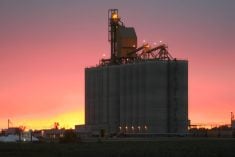BEST BANG FOR YOUR BUCK
Articles end up inGrainews in one of two ways: either I notice a particular topic or have a curiosity about something and ask a writer to tackle it; or writers out on the landscape let me know what they’re thinking of covering and I say yes or no. It’s rare, then, that a story comes back as a real surprise, as I usually know the gist of what will be covered.
When I asked Rhéal Cenerini to follow up on a presentation done at an agronomy conference back in December, I really didn’t expect what I got. The presenter, Kevin Dhuyvetter, an economist from Kentucky State University, outlined a large-scale study looking at what factors had the most (and least) impact on farm profitability (the story is on page 15. Go read it now if you don’t want me to spoil the surprise). I consider myself relatively informed on the topic, so not all the findings were surprising, but the one that really jumped out at me was how little impact crop price and yield have on overall profitability.
Read Also

Cancer agency reclassifies another herbicide ‘probably carcinogenic’
The WHO’s cancer research agency has now put atrazine, a herbicide well known to corn growers, in the same potential-hazard category where the agency put glyphosate.
Say what?
It would seem in nearly every conversation I have with farmers, the subject of “maximizing yield” or squeaking out a few more cents per bushel is the biggest focus. Variety selection usually, rightly or wrongly, starts with yield potential. Crop input decisions are focused on yield-increase potential. Is this focus all in vain?
Well, yes and no.
Dhuyvetter doesn’t say that yield and prices don’t matter, only that the most profitable farms were those with a larger land base (read: economies of scale) and lower costs per unit of production. It’s not about extra bushelsper se,it’s about minimizing the incremental cost to achieve each of those bushels.
And what about crop prices? The study suggests that because farmers are price takers and not price makers, your energy is better spent in working at whittling down costs than trying to hit the highs in the markets.
Does that mean marketing doesn’t matter? Of course not, but it does mean that perhaps it’s time to do a thorough evaluation and tally of your cost of production. What’s one way to do that? On-farm field trials! (I did stray from this topic for one whole issue. You’re welcome.)
BENCHMARKING AND ON-FARM FIELD TRIALS
Why do you do what you do? Do you actually have a good measure on which farming practices have a positive impact on yield — enough to pay for the practice and then some? Likely not. And there’s no need to feel sheepish about it; until relatively recently conducting your own farm trials, evaluations or benchmarking trials was much more cumbersome than it needed to be.
Enter affordable GPS systems and easier to use (but I didn’t say easy) mapping software, and you’ve got a recipe for timely evaluations of common farm practices. We recently featured a story on how attaching a GPS signal to the combine’s yield map helped one farmer discover a 10-bushel an acre mistake (see the cover story of the February 7, 2011 issue). A $5,000 setup saved him $75,000 in previously sacrificed yield because his glyphosate spray timing was off.
In this issue, Brunel Sabourin offers tips on how to set up your own field trial or benchmark evaluation (see page 8 for the story). What’s benchmarking you ask? Think of it as a step beyond evaluating your own practice — it’s first measuring the impact of a practice on your farm, or providing a baseline to compare to, and then taking that outcome and comparing it to what happens on other farms in a similar circumstance.
You might wonder why you’d bother, or you may not want to so publicly compare outcomes, but if you work with any professional agronomist or consulting firm, you should be able to get some of this information (and share yours) without names being passed around. Privacy is a valued thing, and we get that.
But back to trials and benchmarks. If, as Dhuyvetter’s research suggests, costs have more impact on profitability than total yield, it’s worth taking the time to evaluate common practices on your farm, like varieties, fungicide applications and fertilizer rates. Work out the benefits (if any) on a cost per bushel, tonne, etc., and start lining up which practice offers most bang for your buck. I encourage you to choose just one of these topics (cereal variety choice is a manageable one) and tackle it this year. Let me know how it goes.
DRUNKEN CANOLA
Along the same lines as the story above, I really didn’t expect to ever see the words canola and breathalyzer in the same sentence, but if read the story on page 14, you’ll discover there’s an interesting connection between the two.
Turns out, as canola seed takes on water, it gives off alcohol as part of its biological process. The more alcohol given off during this early phase of germination, the lower quality of seed. Taking this knowledge, Wayne Buckley of Agriculture and Agri- Food Canada and some colleagues have created a sort-of breathalyzer for canola seed. What’s even better is the test of seed vigour is actually small, efficient and capable of being completed right on the farm. I bet you can’t wait to find out how tipsy your canola is, can you?
FUEL UP
As I write this, the trouble in Egypt is subsiding as the trouble in Libya heats up. I’m not one for spending a lot of time focusing on geo-political topics, but we live in a very tight-knit world. The problems in the Middle East and North Africa affect us here, usually in the form of higher fuel costs.
And so it is now (I fuelled up my diesel at $1.09 a litre yesterday. In the summer of 2008, I paid as high as $1.45 in Ontario).
Fuel-cost fluctuations are just one reason to have ample fuel storage on the farm, but not necessarily the most important. Tight supplies or a shutdown at a fuel upgrader or plant could mean you fall short of supply at a critical time. What’s more, aged, exposed or single-walled tanks can lead to losses, spills or contamination.
If you’re fuel tanks are in need of a revamp, Scott Garvey has done a great job of detailing what to consider when upgrading to new tanks (page 34) and what to do to safeguard and update older, gravity-flow tanks (page 33).
And for those of you wondering about the coming biodiesel blends and how this might impact on-farm storage, Scott assures me that it’s not likely to be an issue. First, itisimportant to keep summer (most likely to contain biodiesel) and winter diesel separate regardless, but secondly the Saskatchewan Research Council did a full-scale, year-long study into biodiesel use in commercial applications and found no negative impact on storage or use. Follow Scott’s tips for new and older tanks, and you should be fine.
ONE YEAR, THREE YEARS
This issue marks the first full cycle of magazines for me. Next week also marks my daughter’s third birthday. Excuse me while I go make a cake for both of us.
Until next time. Lyndsey














